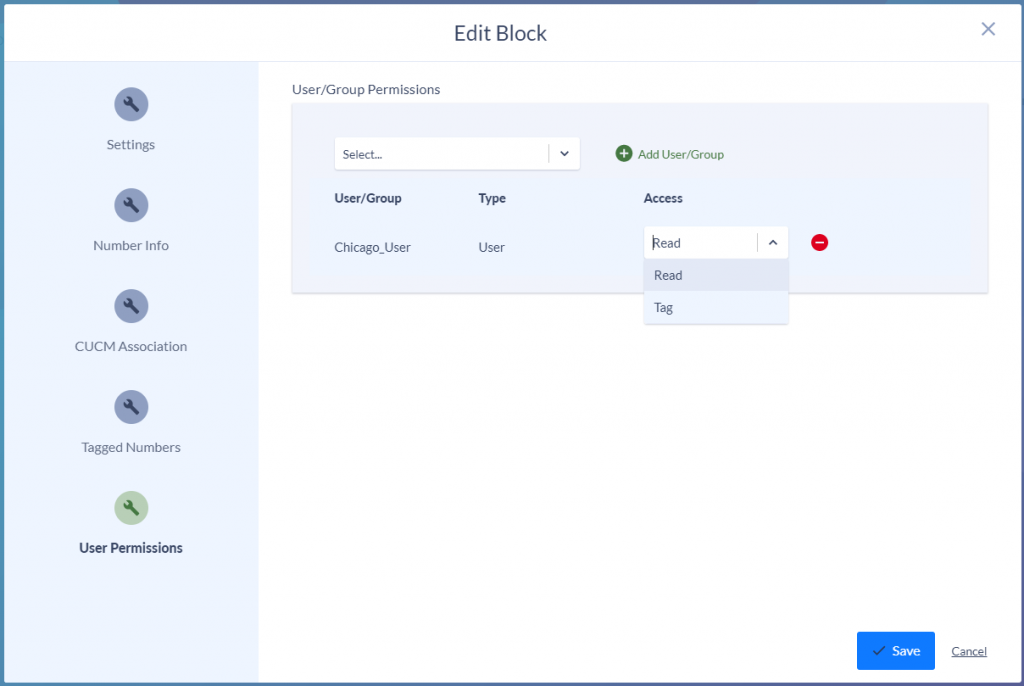DID Blocks
In Variphy, DID Blocks are designed to represent a “block” of DID Numbers used/leased by an organization (via some provider) which share a common country code, area code/NPA and exchange/NXX.
Multiple Blocks can be configured in Variphy, each with a unique name and number range, as well as optional description and meta information, such as provider, circuit/trunk identifier and custom tags.
Example
An organization based in Las Vegas has the following Block of 500 DID numbers which can be called via the PSTN. These DID numbers are assigned to phones/users within the organization.
- +1 (702) – 341 – 4000
- +1 (702) – 341 – 4001
- +1 (702) – 341 – 4002
- …
- +1 (702) – 341 – 4499
In Variphy, this set of DID numbers can be represented by the following DID Block’s number range, which defines the country code, area code (NPA), NXX, and line numbers (also sometimes referred to as subscriber numbers).
Note – Starting in Variphy release 12.4.0 a user will be able to configure a block’s Area Code and NXX with any 3 digit sequence. This will allow the ability to manage non-DIDs (sometimes with leading 0’s or 1’s) in the same way DIDs are within the tool set.
DID Block Number Info
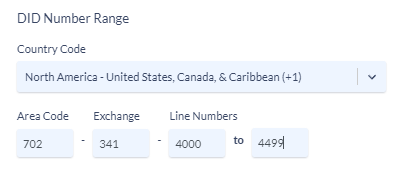
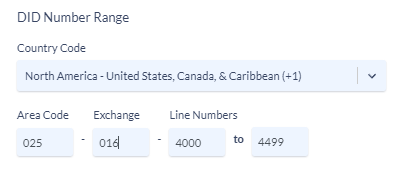
DID Block Settings
The DID Block is assigned a unique name, such as “HQ 702-341-4xxx”, along with optional description, provider and circuit/trunk ID information.

DID Block Number Association with CUCM Numbers
The organization has a single CUCM Cluster with an internal dial plan consisting of 4 digit directory numbers (DN). These DN’s have a route partition “PT-Directory-Numbers”, which are assigned to phones, end users and applications in the CUCM Cluster.
Inbound calls from the PSTN to their DID numbers (702-341-4000 to 4499) are mapped to their internal directory numbers by stripping out the 6 left-most digits (excluding the country code), leaving only the 4 right-most digits line number.
Inbound call from PSTN to +1 (702)-341-4105 routes to Directory Number 4105 (PT-Directory-Numbers)
This relationship among the DID Block’s numbers with directory numbers in a CUCM cluster (“10.20.30.45”) can be configured as follows, where the DN Digit Match Count field specifies that the right most 4 digits from the DID number should be mapped to directory numbers in the “PT-Directory-Numbers” route partition.

Configuring DID Blocks
Within the DN & DID Management feature, select the Configure tab, which is only available and visible to system administrator users.
Selecting the DID Blocks tab will display all existing Blocks in Variphy. For each Block, the assigned name, assigned site(s), provider, number range and summary will be shown.
Note: At least 1 DID Site must exist before configuring DID Blocks.

Creating or Editing a DID Block
To create a new DID Block, click the Create DID Block button, which will open the DID Block configuration window.

To edit an existing DID Block, click the edit icon for the desired Block, which will open the DID Block configuration window.

Deleting an Existing DID Block
To delete an existing DID Block, click the delete icon for the desired Block, which will show the configuration window.

In the confirmation window, click the Confirm button to delete the Block, or Cancel to return to the list of Blocks.

DID Block Configuration Window
Settings
| Field | Notes |
| Name | Required – Specify a unique name |
| Description | Optional – Specify a description if desired |
| Provider | Optional – Specify the DID Block provider, if desired |
| Circuit/Trunk ID | Optional – Specify the DID Block’s Circuit or Trunk ID, if desired |
| Sites | Required – Each DID Block must be assigned to at least 1 DID Site. |
Note: For more information on configuring DID Sites click here.
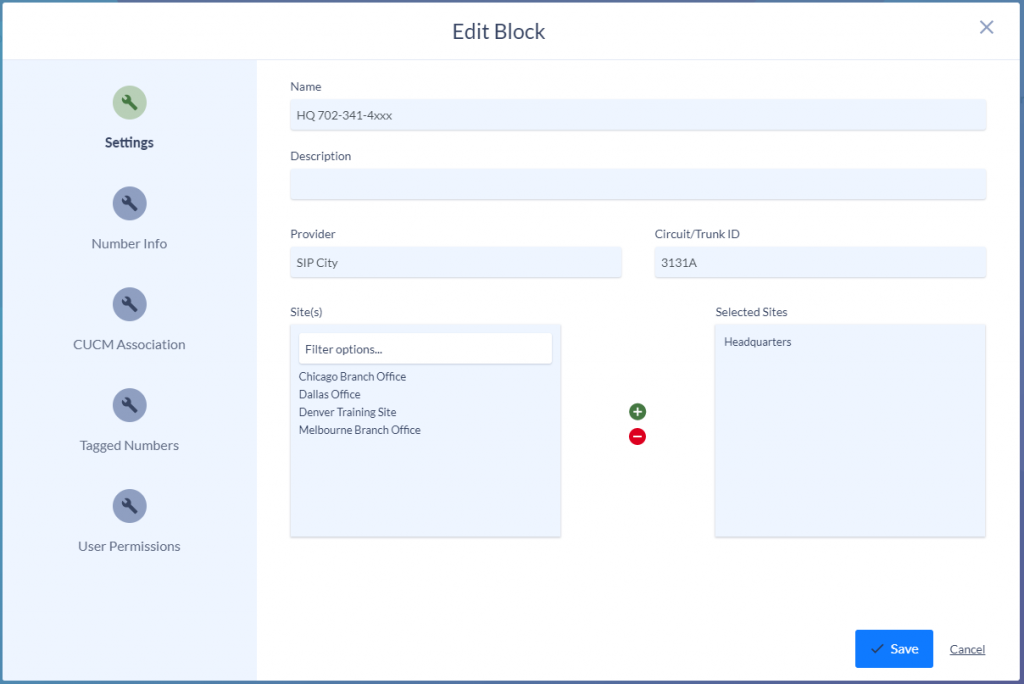
Number Info
This section defines the key numbering information for the Block, including which numbers are included as well as those which should be excluded, if any.
| Field | Notes |
| Country Code | Required – Select the appropriate Country Code |
| Area Code | Required – Specify the 3 digit Area Code |
| NXX | Required – Specify the 3 digit NXX |
| Line Numbers | Required – Specify the 4 digit range (start and end) |
| Excluded Numbers | Optional – Within the Area Code and NXX numbering, specify either single (start with no end) or a range (start and end) of line numbers to be considered as excluded and ignored from the DID Block |
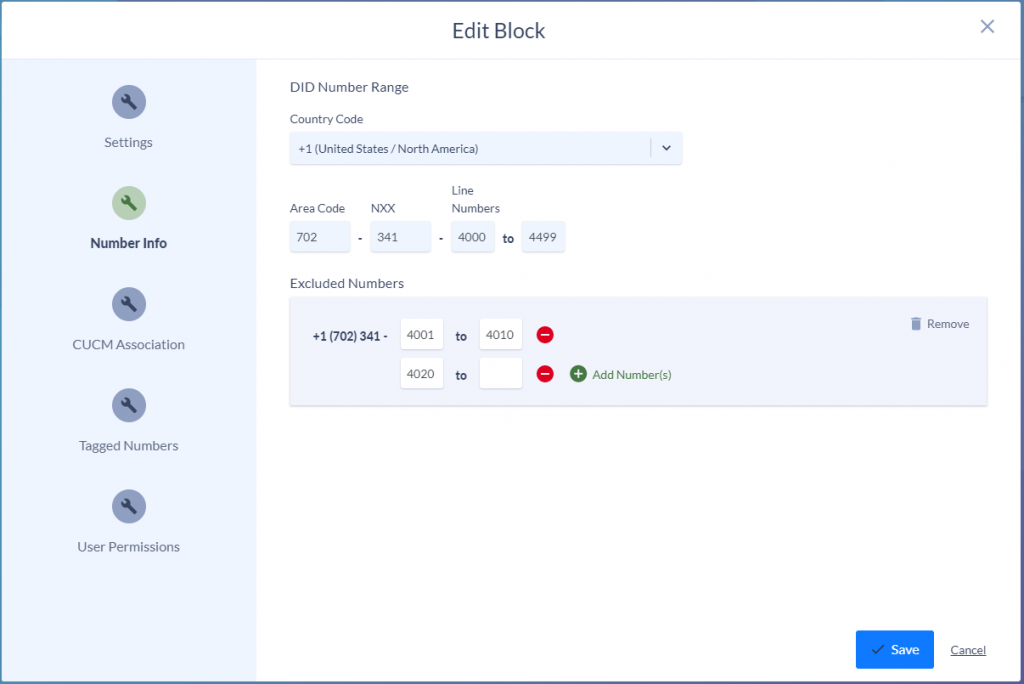
CUCM Association
Each DID Block must be associated to at least 1 CUCM Cluster. A DID Block can be associated to multiple CUCM Clusters.
Variphy will determine DID number status and availability based upon the real-time directory number configuration for all associated CUCM Clusters.
A DID number is only deemed to be available if no corresponding directory number (either through normal association or mapping exceptions) exists in any of the associated CUCM Clusters and also if the number is not excluded from the DID Block range.
To add an associated CUCM Cluster to the DID Block, select the appropriate Cluster and then click the Add CUCM Cluster button.
To remove an associated CUCM Cluster from a DID Block, click the Remove button for the appropriate Cluster.

Per CUCM Cluster Association Fields & Settings
| Field | Notes |
| E.164 Prefix | Toggle – Dictates if the E.164 prefix (“\+”) should be included before the Country Code |
| Site Codes/Prefix | Optional – 1 or multiple digit sequences which represent site codes or prefixes to prepend when associating DID numbers to CUCM Directory Numbers |
| DN Digit Match Count | Required – Defines the # of digits (starting from the right/end of the DID Number) to match with that of CUCM Directory Numbers |
| Any Route Partition | Toggle – Dictates whether any or only specific CUCM Route Partitions should be considered |
| Route Partition | If the “Any Route Partition” is toggled off, this field specifies which CUCM Route Partition(s) which should be considered |
| DN Mapping Exceptions | Optional – It’s very common for a specific DID number to not be corresponded with a DN through exact match. (e.g. Translation Patterns). DN Mapping Exceptions allow you to still correlate DID numbers with a random DN. |
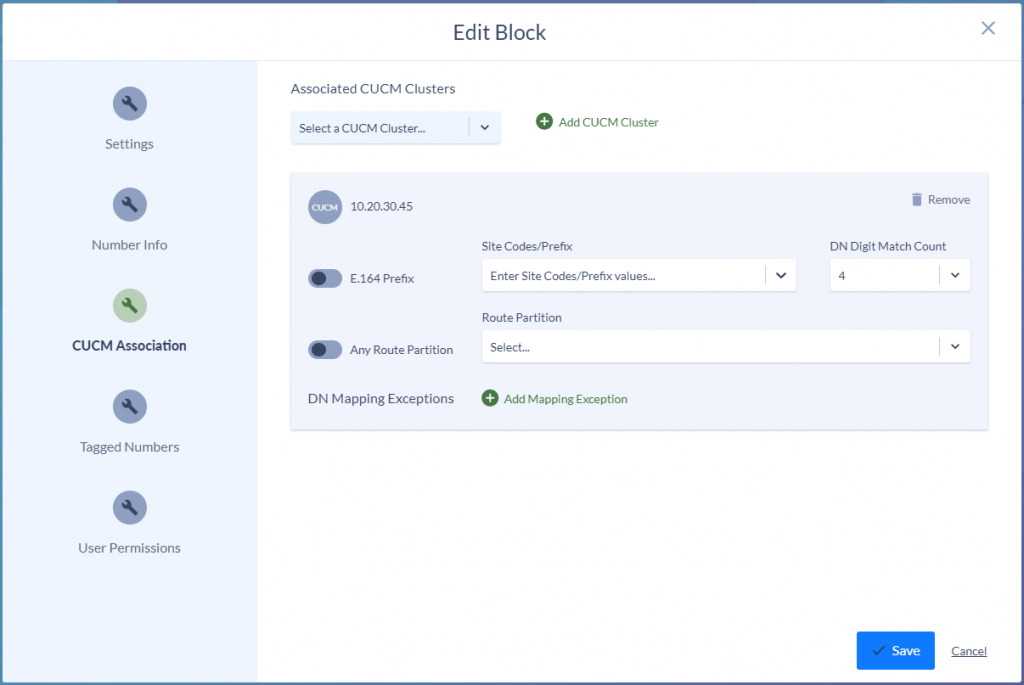
CUCM Cluster Association Mapping Examples
Example 1 shows the most basic association/mapping scenario, where the last 4 digits (“4102” in this example) of the DID numbers (e.g. the full Line Number) map directly to Directory Numbers within the CUCM Cluster.


Example 2 shows another basic association/mapping scenario, where the last 7 digits (“3414102” in this example) of the DID numbers (e.g. the full NXX + Line Number) map directly to Directory Numbers within the CUCM Cluster.


Example 3 shows an expanded association/mapping scenario, where a Site Code/Prefix of “5” prepended to the last 4 digits (“4102” in this example) of the DID numbers (e.g. the full Line Number) map directly to Directory Numbers within the CUCM Cluster.


Example 4 shows an association/mapping scenario, where the E.164 Prefix (“\+1”) should be prepended to the last 10 digits (“7023414102” in this example) of the DID numbers map directly to Directory Numbers with the “PT-Directory-Numbers” Route Partition only, within the CUCM Cluster.


Example 5 shows an association/mapping scenario, where either prefixes “55” or “66” should be prepended to the last 4 digits (“4102” and “4488” in this example) of the DID numbers map directly to Directory Numbers with the “PT-Directory-Numbers” or “GLOBAL-UCCXDN-PT” Route Partitions only, within the CUCM Cluster.


DN Mapping Exceptions
Individual Mapping Exceptions which specify special mappings from DID numbers to CUCM Directory Numbers can also be configured as part of the DID Block’s CUCM Cluster Association settings.
Mapping Exceptions take precedence over “normal” mappings which result from the DID Block’s CUCM Cluster Association settings.

This mapped exception states that the (702)-341-4300 is being mapped directly to 8800 and is excluded from the “normal’ CUCM Association.
Tagged Numbers
Single number or ranges of numbers in a DID Block can be tagged with a beta-data label.
To add a Tagged Number/Range to the DID Block, click the Add Tagged Number(s) button and then enter a single number or range of numbers to Tag. In the Tags field, specify 1 or more Tags.
To remove a Tagged Number/Range from a DID Block, click the Remove button for the appropriate Number/Range.
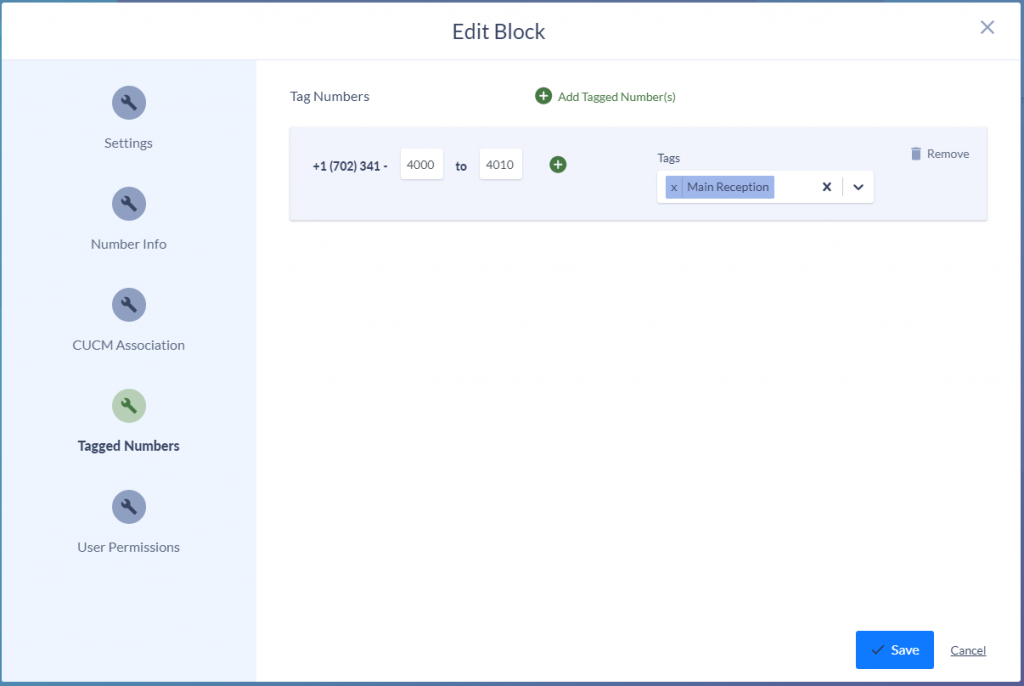
User Permissions
All System Administrator users automatically have full access to each DID Block configured in the system.
To add additional privileges, select the appropriate users/groups and click the Add User/Group button.
Select the desired Access type:
Read: The user/group can only view assigned Tags to DID numbers via search results.
Tag: The user/group can view as edit Tags to DID numbers via search results.
